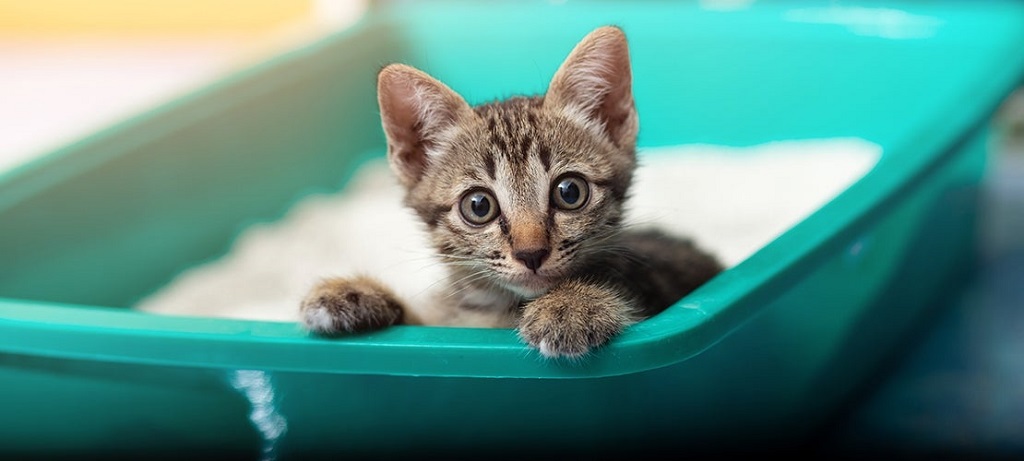Kittens must be able to access their litter box easily. They may not use it if it is too high or requires climbing. Place kittens in their litter box several times daily, especially after meals and playtime. Never punish them for eliminating outside the litter box; yelling and hitting only teach them to avoid the box.
Understand Your Kitten’s Personality
Often, kittens who are eliminated outside their litter box try to tell you there’s something wrong—medically or emotionally. It’s a good idea to check with your veterinarian, especially if the problem persists, after double-checking your cleaning schedule and ensuring their box is big enough and in a quiet place. Kittens can be very picky about the type of litter they use. Try different options to see what works best for your kitten. Kittens may need to retrain themselves to use the new litter, which can take time. Be patient, and don’t give up! Gently and without fuss, pick your kitten up and put them in their litter tray from Chewy.com first thing in the morning, immediately after meals, after periods of energetic play, before naps, and at night. This will help establish a routine and decrease their chances of eliminating elsewhere. Watch for signs they need to poop, such as sniffing and crouching, and position them in their litter tray when they display these behaviors. When they’re done, praise them and give them a treat to encourage them to use their litter box again. Never rub their nose, hit them, or yell at them for eliminating outside the litter box, as they will learn to associate their bathroom activities with negativity and avoid using their tray altogether.
Understand Your Cat’s Needs
A cat has many needs that need to be fulfilled. Among them are social interaction, exercise, food and water, play, sleep, toys, grooming, and security. A cat must meet all of these needs to be happy and healthy and be able to use the litter box consistently. For example, if your kitten is eliminating outside the box, it might be because it’s too noisy or busy in the area, and it’s challenging to focus on going potty. Another possibility is that they’re uncomfortable in the box and don’t like how it feels on their paws, smells terrible, or the litter doesn’t feel right. They might also be sensitive to clay, or the litter isn’t the correct type. If this is the case, try a different litter and see if they use it more comfortably. It could also be that the box is too small for them, and they’re having trouble getting in and out. Then there’s the issue of accessibility, such as if they have to climb stairs or jump over something to get to it. The box must be easy to reach. Also, if they’ve been using it regularly and then suddenly stopped, it may be a sign of a medical issue that needs to be evaluated by a veterinarian.
Understand Your Environment
Many kittens pick up litter box training naturally by the time they are 12 weeks old, but new homes, changes in routine, or a reluctance to eliminate in the box can set them back temporarily. During this period, try to make eliminating them in the litter box easy. If they revert to soiling outside the box, clean the area with an enzymatic odor neutralizer and remove objects from the site that may have been appealing to them (chairs, end tables, trash cans) to discourage them from returning to those locations. When eliminating kittens, cats need privacy, so keep the litter box in a quiet but easily accessible location. It should be large enough for them to enter and exit comfortably. It is also best to choose a plain, unscented, clumping litter and avoid a covered litter box, as your cat may feel too confining. If they start eliminating outside their litter box, don’t scold them. Punishing them will only teach them to hide their elimination from you and to avoid the litter box altogether. Instead, distract them with a treat or their favorite toy and lead them to the litter box. Place the litter box far from their food dishes, water, or favorite sleeping spots. Cats have a strong sense of smell and prefer to eliminate areas with a different scent from their food and water.
Understand Your Kitten’s Needs
Most kittens pick up on litter box training quickly, but it’s not uncommon for them to relapse or have accidents from time to time. If this happens, try to figure out what is causing the problem. For example, if the kitten refuses to use their box, try using a different type of litter (clumping versus non-clumping) to see if that makes a difference. The litter box may need to be cleaned more frequently or be dumped and filled to encourage your cat to use it. Another possible reason for your kitten not using the litter box is that it is too difficult to access. For example, if your kitten is older and has joint pain or stiffness, the side of the box might be too high for them to climb over comfortably. A change in the environment, stress, or being scolded near the box can also cause cats to stop using it. Be sure to show your kitten the litter box’s location, and don’t move it around. Also, please place it in an area that is private yet accessible. A cat’s sense of smell is vital, so don’t put the litter box in a small closet or corner where their food dishes are or near their favorite sleeping spots. These areas will be more attractive than the litter box and may encourage your kitten to eliminate outside the box.




